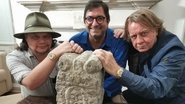
Nazi Relics
Hamilton has amassed an extraordinary collection of Nazi memorabilia. These include a collection of Nazi badges that were sold to raise money for the German poor, and an ammunition box full of silver bullion bars that were found buried close to a concentration camp in Poland. The badges incorporate many symbols from other ancient religions and cultures that the Nazis used to promote the myth of an Aryan master race. The Nazi relics have a deeply personal resonance for Janina as she is Polish, and her grandmother was interned in a Nazi labour camp during the war. Janina begins her part of the investigation into the Nazi obsession with religious symbolism by looking into Nazi Grail hunter Otto Rahn, the inspiration behind the Indiana Jones movies. She discovers documents that reveal Rahn, who eventually committed suicide, was gay and had Jewish ancestry. Carl and Hamilton begin their investigation at a stunning mountain-top monastery at Monserrat in Spain.
Country: GB
Language: En
Runtime: 42
Season 2:

Carl Cookson and Hamilton White investigate a Crusader sword and helmet that date back more than 900 years. Oxford historian Dr Janina Ramirez helps them decode the symbolism on these ancient relics to show that the sword may have been used in the First Crusade when Christian knights retook the holy city of Jerusalem, and that the helmet, embossed with the Lion of St Mark, was made in Venice. Travelling to Italy’s ‘floating city’, Carl and Hamilton learn more about how and why Venice adopted St Mark as its patron saint and went on to become a leading maritime power – eventually supplying crucial ships for the Crusades. They also discover that, on the way to Jerusalem, the Venetians chose to attack the Christian city of Constantinople to recoup losses they had sustained in building the fleet. In the archives Janina discovers a powerful and vivid first-hand account of the “Sack of Constantinople” by a government official who was living in the city at the time.

Carl and Hamilton investigate an extraordinary collection of Celtic gold from the Iberian Peninsula that dates back thousands of years. Amongst the rare artefacts are a gold bowl worth over £1m, fine pieces of jewellery depicting the goddess Astarte, and a stone altar to the god Endovelicus which might have been used in rituals that involved blood sacrifice. Travelling to Portugal, where most of the Celtic gold is from, Carl and Hamilton meet up with Joao, their long-time local guide and collaborator. The three men travel to the site of a very rare temple devoted to Endovelicus and explore how the temple might have been used to worship the god. Carl and Hamilton meet up with forensic archaeologist and former police detective Roger Box. They want to find out more about the Roman symbolism that appears on the Celtic altar, and Roger takes them to the site of a Roman temple in the Cotswolds.

Carl and Hamilton are back on more familiar ground with a stunning white marble chalice from Hamilton’s Knights Templar treasure hoard, where the relics they explored in the first series came from. They travel to Chartres Cathedral in France, believed to have been built by the Templars, to examine a depiction of a very similar chalice on the north portico. Inside the Cathedral they also come across a famous depiction of a black Madonna which is at the centre of a Christian cult and was also revered by the Templars. Wanting to find out more about the cult of the black Madonna, Carl and Hamilton travel to a spot in the south of France which has given rise to an extraordinary theory – made popular by the novel and movie The Da Vinci Code – that Mary Magdalene travelled from the Holy Land after the crucifixion and was carrying Jesus’ child. Back in the UK, Janina looks at some of the sources that inspired The Da Vinci Code.

In Hamilton’s possession is a wooden chest stuffed full of relics from medieval Christian pilgrimages. These include clamshell pendants from the Camino de Santiago in Spain and Jerusalem crosses from the Holy Land. In addition, Hamilton has two stone carvings. One is of a pilgrim clad in a cloak and carrying a book and staff; the other is very similar except that he is carrying a spear. Carl and Hamilton’s journey starts in the south of France, the traditional starting point of the Camino. They traverse the Pyrenees, stopping off at key landmarks like Charlemagne’s Cross, where pilgrims lay tributes and say prayers to St James. Descending the other side of the Pyrenees and crossing into Spain, Carl and Hamilton come to a strategic castle that was a flashpoint during the bloody war fought between Christian and Muslim forces for control of this region in the Middle Ages.

Hamilton has amassed an extraordinary collection of Nazi memorabilia. These include a collection of Nazi badges that were sold to raise money for the German poor, and an ammunition box full of silver bullion bars that were found buried close to a concentration camp in Poland. The badges incorporate many symbols from other ancient religions and cultures that the Nazis used to promote the myth of an Aryan master race. The Nazi relics have a deeply personal resonance for Janina as she is Polish, and her grandmother was interned in a Nazi labour camp during the war. Janina begins her part of the investigation into the Nazi obsession with religious symbolism by looking into Nazi Grail hunter Otto Rahn, the inspiration behind the Indiana Jones movies. She discovers documents that reveal Rahn, who eventually committed suicide, was gay and had Jewish ancestry. Carl and Hamilton begin their investigation at a stunning mountain-top monastery at Monserrat in Spain.




















